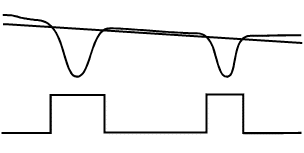Thresholding or binarization, the conversion of the native
grayscale image in a scanner into a binary image, is a key
technology for successful document imaging. Traditional
thresholding has been based on suppressing background rather than
finding foreground. Picture Elements, Inc. has developed a family
of algorithms based on the principles used in human vision
itself: finding edge information and accurately reproducing the
widths of features in the original grayscale image.
Edge Thresholding Produces Accurate Feature Widths



Traditional Dynamic Thresholding Still Can Produce Images
Which AreToo Light ...



... Or Too Dark



Automatic
These edge thresholding algorithms are robust and highly
automatic. They perform well in the face of widely varying
document contrasts with a single, automatic setting.
Picture Elements has developed chip and board implementations
of these leading edge techniques for a few sophisticated systems
integrators and scanner manufacturers. Top image quality has
proven to be a key discriminator in the crowded, me-too document
imaging world. These technologies are now available on the PCI
bus.
Fast
The Picture Elements team of seasoned imaging engineers has
developed chip and board thresholder implementations at 30 to 80
MHz pixel rates.
- The VST-1000 thresholder chip can be
embedded in a scanner for modest cost.
- The Picture Elements THR Board
incorporates the VST-1000 chip and can operate on
grayscale images from the PCI bus.
- The Picture Elements ISE Board on the
PCI bus gives this high quality thresholding function
along with grayscale deskew, grayscale scaling, and
simultaneous JPEG compression of the source
grayscale image.







